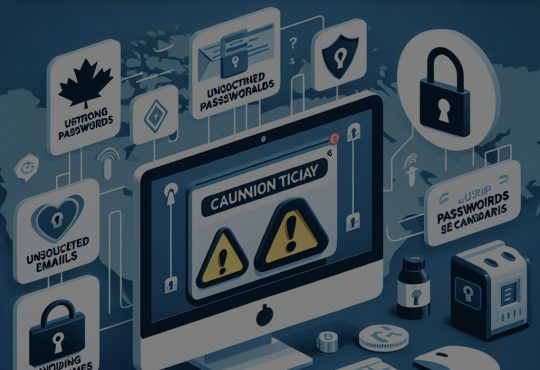
In an increasingly digital world, understanding online security threats has become paramount for individuals and organizations alike, particularly in Canada where the internet is an integral part of daily life. Cybercrime is not just a concern for tech-savvy individuals; it affects everyone from government agencies to small businesses and everyday Canadians. As the methods of cybercriminals evolve, so too must our awareness and response strategies. This article delves into the common online security threats faced in Canada, offers strategies for protection, and highlights resources for staying informed.
Identifying the Most Prevalent Online Threats in Canada
One of the most common online threats faced in Canada is phishing. This technique involves cybercriminals impersonating legitimate organizations to deceive individuals into providing sensitive information, such as passwords or credit card numbers. Phishing attacks can come in various forms, including emails, messages, and even phone calls, making them particularly difficult to identify. With the rise of advanced phishing schemes, many Canadians find themselves unwittingly at risk.
Another significant threat is ransomware, where malicious software encrypts a user’s data, rendering it inaccessible until a ransom is paid. The frequency of ransomware attacks has surged in Canada, with businesses, hospitals, and educational institutions frequently targeted. Unfortunately, paying the ransom does not guarantee the recovery of data, and it encourages further attacks. The devastating impact of such threats has prompted many organizations to reassess their data security strategies.
Data breaches are also on the rise, often resulting from poor security practices or unpatched software vulnerabilities. These breaches can lead to the unauthorized access and theft of personal data, which can have severe consequences for both individuals and organizations. Canadians have witnessed significant breaches affecting major corporations, illustrating how personal information can be compromised in a matter of seconds.
Lastly, social engineering attacks exploit human psychology to manipulate individuals into divulging confidential information. Cybercriminals use tactics such as impersonation or urgency to trick victims into acting against their better judgment. In Canada, increasing awareness about these tactics is essential, as many people remain unaware of the psychological factors that make them susceptible to such attacks.
Strategies to Protect Against Cybersecurity Risks
To safeguard against online threats, employing strong, unique passwords for different accounts is a fundamental strategy. Password managers can facilitate this process, generating and storing complex passwords securely. It is equally important to enable two-factor authentication (2FA) wherever possible, adding an additional layer of security to account access. This simple measure can significantly reduce the likelihood of unauthorized access.
Regular software updates are another crucial defense against cybersecurity risks. Keeping operating systems, applications, and antivirus software up to date ensures that devices are equipped with the latest security patches. Cybercriminals often exploit software vulnerabilities, and timely updates can close these gaps before they are exploited. Canadians should adopt a proactive approach to maintain the integrity of their digital environments.
Awareness training is vital for organizations, as human error is often a weak link in cybersecurity. By educating employees about common threats like phishing and social engineering, businesses can cultivate a culture of security. Regular drills and simulations can further prepare individuals for potential attacks, enabling them to recognize and respond to suspicious activities effectively.
Lastly, utilizing firewalls and network security measures can greatly enhance protection against various online threats. Firewalls act as barriers between a trusted internal network and untrusted external networks, filtering incoming and outgoing traffic. Canadians should consider investing in comprehensive cybersecurity solutions that offer multi-faceted protection, ensuring a robust defense against evolving threats.
Resources for Staying Informed on Security Issues
To stay informed about online security threats, Canadians can turn to reputable organizations such as the Canadian Centre for Cyber Security (CCCS). The CCCS provides timely information on emerging threats, best practices, and resources for individuals and businesses. Their website features alerts and advisories that can help Canadians remain aware of the latest cybersecurity trends.
Another valuable resource is the Cyber Security Information Centre (CSIC) which offers guidance on protecting personal information and reporting incidents. The CSIC’s website provides tools and tips aimed at helping Canadians understand the risks associated with online activities. By utilizing these resources, individuals can equip themselves with the knowledge necessary to navigate the digital landscape safely.
Social media platforms and news outlets also play an essential role in disseminating information about cybersecurity threats. Following trusted cybersecurity experts and organizations on platforms like Twitter or LinkedIn can provide real-time updates on new threats and security breaches. Additionally, subscribing to newsletters from security firms can deliver curated content directly to inboxes, keeping subscribers informed and alert.
Lastly, participating in local cybersecurity workshops or webinars can provide hands-on knowledge and foster community engagement. These events often feature experts who share insights on the latest threats and defensive strategies. By actively engaging in the conversation about cybersecurity, Canadians can create a more informed society prepared to combat online security threats.
In conclusion, as the digital landscape continues to evolve, so too do the threats that come with it. Understanding common online security threats in Canada is essential for safeguarding personal and organizational information. By implementing effective strategies and leveraging available resources, individuals can better protect themselves against the pervasive risks of cybercrime. Remaining vigilant and informed is not just a personal responsibility; it is a collective endeavor that fosters a safer online environment for all Canadians.






